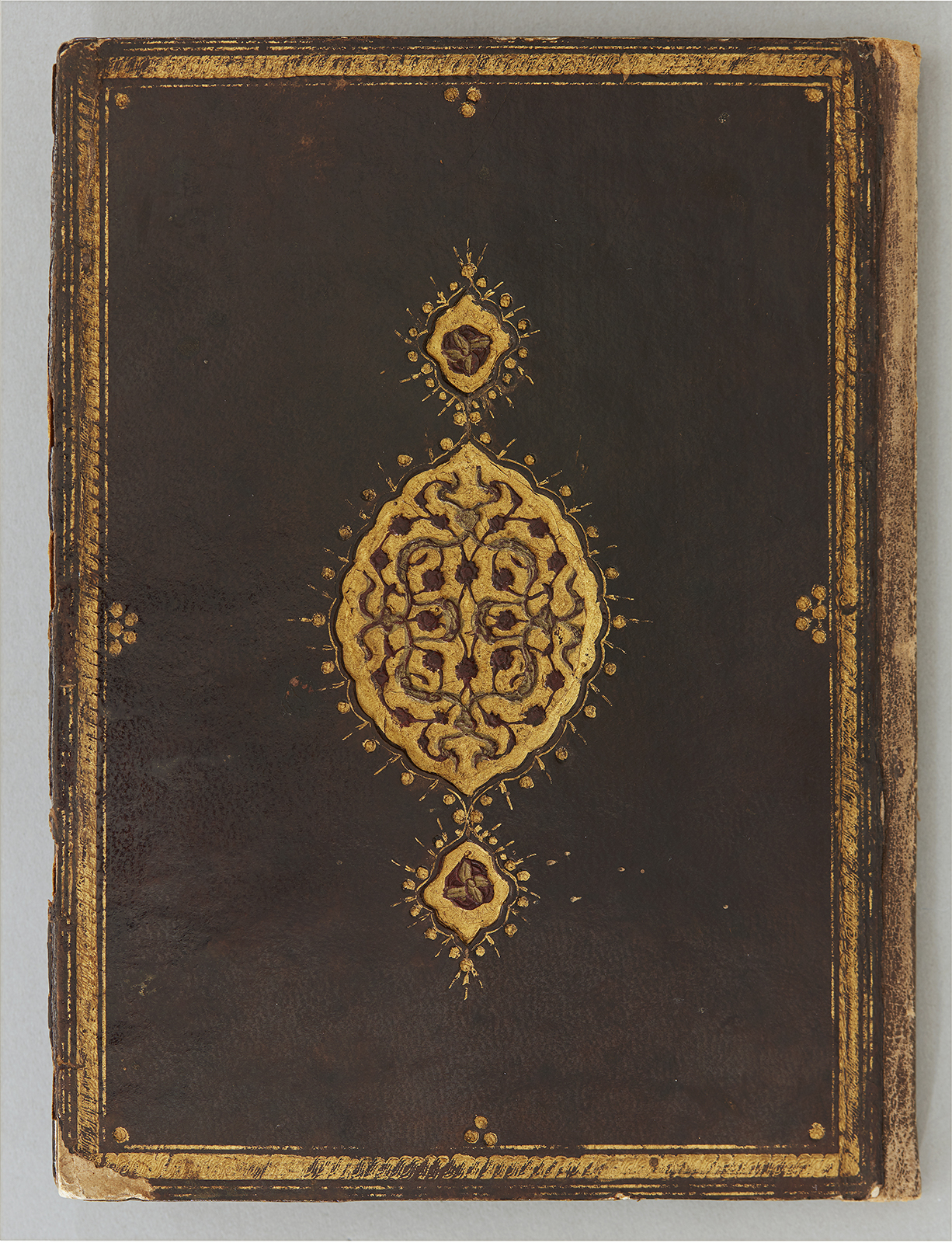Click on the image to zoom
Manuscript of the Spiritual Words from Greek Philosophy with Sayings of the Philosophers Accompanied with their Portraits
Al-Kalimat al-Ruhaniyya min al-Hikam al-Yunaniyya fi Kalimat al-Hukama’ wa Ashkalihim
- Accession Number:AKM283
- Creator:Artist (calligrapher attributed): Yaqut Al-Musta'simi, died 1298
Artist (painter attributed): Mahmud b. Abi'l-Mahasin Al-Qashi - Place:Iraq, Baghdad
- Dimensions:21.2 cm x 15.7 cm x 1.3 cm
- Date:late 13th century; additions made 1899
- Materials and Technique:opaque watercolour, ink, and gold on paper
Manuscript of the Spiritual Words from Greek Philosophy with Sayings of the Philosophers Accompanied with their Portraits (Al-Kalimat al-Ruhaniyya min al-Hikam al-Yunaniyya fi Kalimat al-Hukama’ wa Ashkalihim), presents collected maxims in Arabic attributed to Greek philosophers and notables. The volume contains an illuminated heading (fol.1r) and 13 textual illustrations can be attributed to late 13th-century Baghdad.
To view the 13 textual illustrations, see AKM283.f3v, AKM283.f16r, AKM283.f19r, AKM283.f21v, AKM283.f23v, AKM283.f26r, AKM283.f27r, AKM283.f29r, AKM283.f30r, AKM283.f31v, AKM283.f36r, AKM283.f38v, AKM283.f41v
Further Reading
AKM283 additionally has two flyleaves both at its beginning and its end. Three of these four flyleaves were clearly added during the last rebinding of the manuscript in paper that matches the one covering the doublures of the binding;
The verso (v) side of the first front flyleaf has the note, “46 feuilles / 1 feuille d’ornement / 13 miniatures (46 leaves / 1 leaf of ornament / 13 miniatures), written in French.
The second front flyleaf is attached to the text. Its recto (r) side of bears three ownership notes: the name Hacı (khvaju) Ibrahim Efendi is written on the top centre of the page; the name Imamzada Muhammad is written above the seal with the same name on the left edge of the page; and below this seal there is the name of Ahmed Hamdi b. Muhammed Emin, with the date 1 Jumada II, 65.

The verso side of the second front fly leaf, (pictured below) has a Persian couplet, which praises the scribe of the manuscript Yaqut al-Musta'simi (d. 1298), whose name is found in the colophon on the recto of the folio (fol.46r).[3]
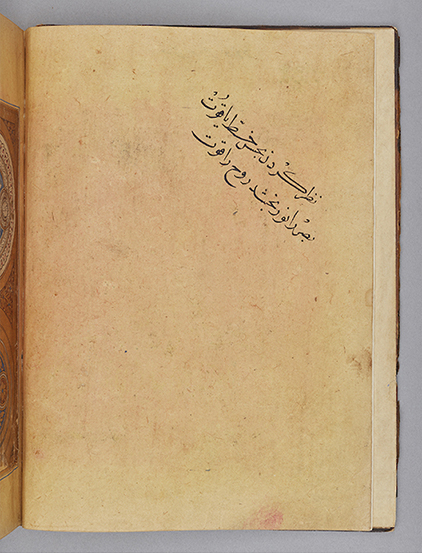
In the illuminated opening page of the manuscript (fol.1r) the title of the work is inscribed in two lobed cartouches that fill up the ruled central area. The top one is inscribed with the first part of the title in gold letters over an illuminated blue ground: “Al-Kalima al-Ruhaniyya min al-Hikam al-Yunaniyya,” while the lower one has the second half of the title in white letters against a gold ground surrounded by illumination that fill up the cartouche: “fī Kalimat al-Hukama’ wa Ashkalihim.” A similar lobed cartouche is found as the illuminated heading of a manuscript from the Süleymaniye Library in Istanbul (Nuruosmaniye 4907) that carries the name of the same celebrated Abbasid/Ilkhanid scribe Yaqut al-Musta‘simi as that of the AKM283, together with the date 20 Ramadan 689 (September 1290), which helps date AKM283 to the same period. [1] The illuminated title page fol.1r of AKM283 has some later seals, as well as a pençe (lit. “paw”) sign used as a signature by high-ranking Ottoman officials.[2] Two of the three seals on fol. 1r feature a small round seal with a line of prayer, while the third one is a seal dated “1/179” belonging to the Ottoman mathematician named Mustafa Sıdkı (d. 1769), who had translated Greek works.[4]
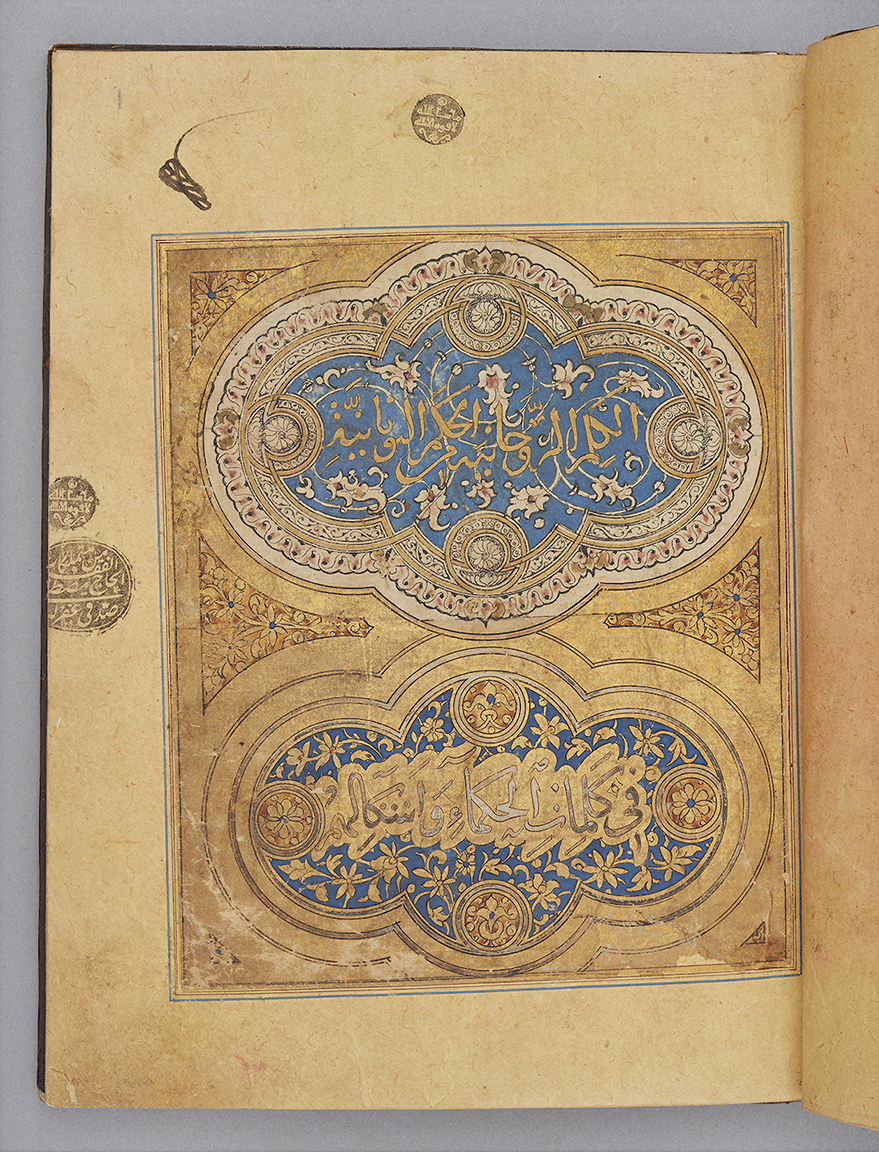
Besides its illuminated title page, the codex also closes with an illuminated cartouche marking the end of the text below the colophon on fol.46r.
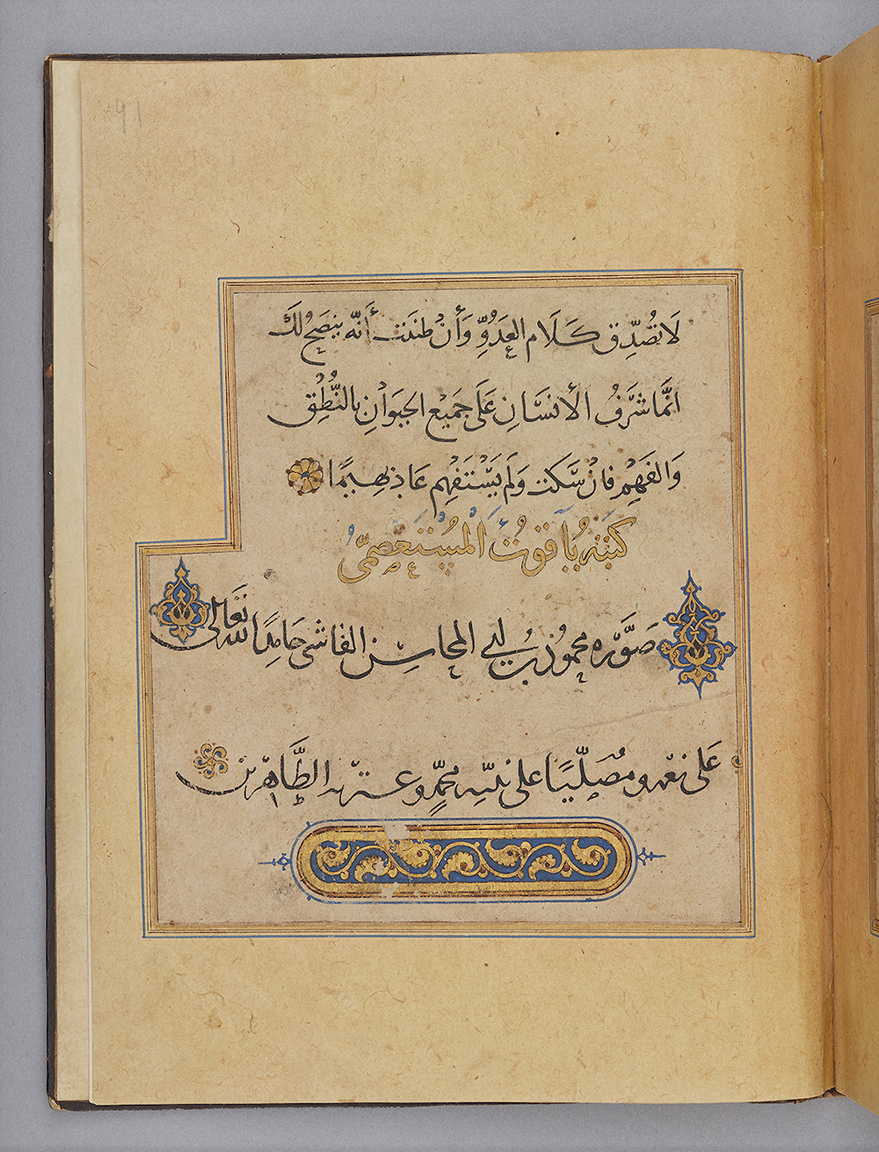
The recto (r) side of the last flyleaf has a pasted piece of paper with a Persian couplet in the form of a muamma (riddle) for the name of ‘Ali. This is followed by an Arabic couplet by ‘Ali b. Abi Talib and an Ottoman explanation which calculates the unlucky dates of a month using the abjad values of the letters with diacriticals from ‘Ali’s couplet.
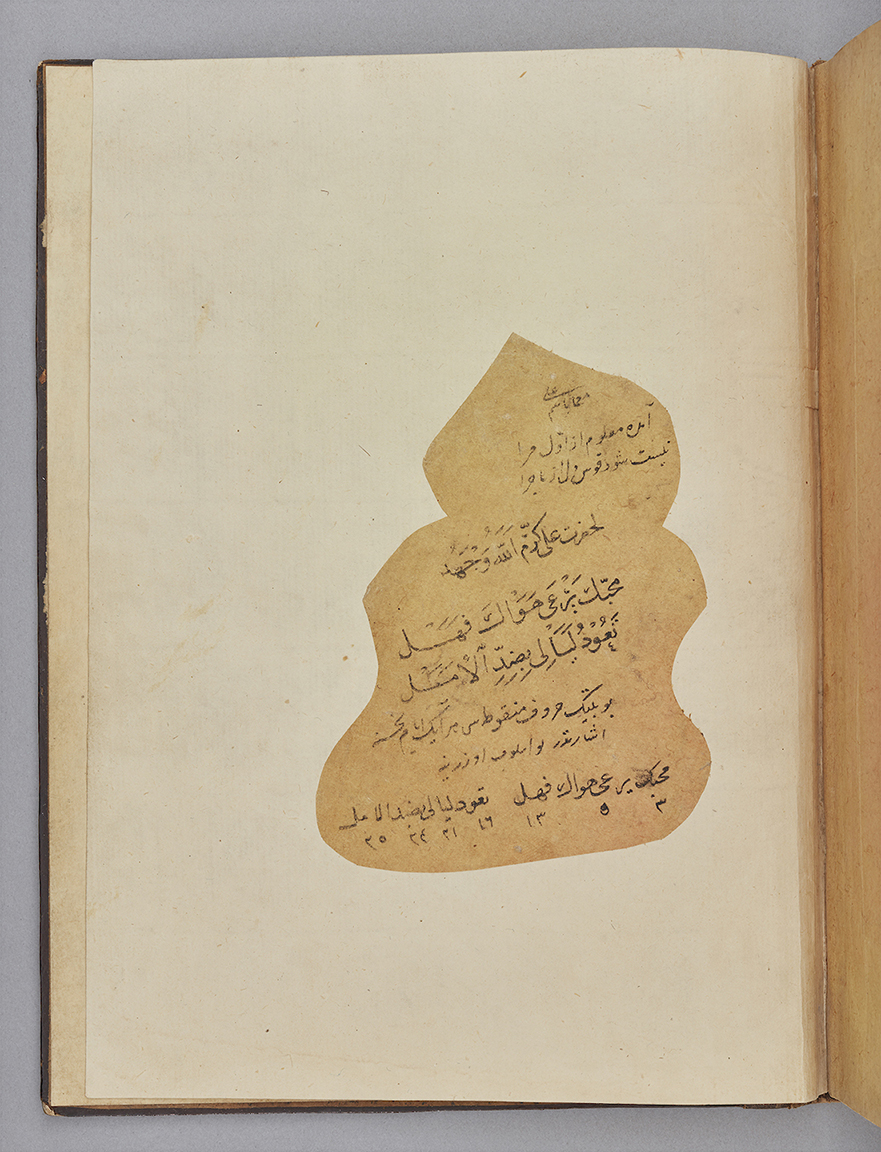
At least six copies of Al-Kalima al-Ruhaniyya min al-Hikam al-Yunaniyya are found in the Süleymaniye Library in Istanbul. Two are closely related to AKM283. The first one (Ayasofya 2452) is dated Safer 668 (September 1269), gives its place of production as Madinat al-salam (Baghdad), and is also signed as Yaqut b. Abdallah summa al-Musta‘simi. The second (Fatih 4041) does not have the name of its scribe, but is dated 1 Rajab 697 (April 1298) and also gives its place of production as Medinat al-salam. Fatih 4041 is additionally important since it bears the almond-shaped imperial seal of the Ottoman sultan Bayezid II (r. 1496–1512) featuring his tughra (monogram). Furthermore, since this volume was catalogued in the inventory of the holdings of Bayezid’s imperial book treasury in Istanbul drawn by his royal librarian ‘Atufi (d. 1542) in 909 (1503–4), it had clearly entered the royal treasury by this date.[5]
A previously unnoted copy of a collection of maxims from the Süleymaniye Library Istanbul (Fazıl Ahmed Paşa 1205)[6] may also have been among Bayezid’s holdings, since it is stamped by Bayezid’s almond-shaped imperial seal. It is significant for the present discussion, since the maxims it includes may have been gathered by Yaqut al-Musta‘simi himself. Yāqūt’s name is found both in its title, Asrār al-Ḥukamā’ min qabīl al-naṣīḥat wa al-tasawwuf li Yaqut al-Musta‘simi bi khattihi (Secrets of Sages as a miscellany of wise counsels and sufism by Yaqat al-Musta‘simi in his Own Hand) and in its colophon (fol. 136b) dated Dhī al-hijja 689 (December 1290), which claims that it was written (katabahu) and compiled (jami‘hu) by the author (al-mu’allif) of the miscellany, Yaqut al-Musta‘simi. It generally follows the mirror of princes genre, while some of the maxims it includes, attributed to Aristotle or Alexander, also relate it to similar works called Nasa’ih-i Iskandar (The Counsels of Alexander).
The Süleymaniye copy of the Asrar al-Hukama (Fazıl Ahmed Paşa 1205) may be one of those volumes which had been produced as a duplicate of a work by Yaqut in the 15th century, since the illuminated medallion inscribed with its title (fol.1a) stylistically appears to belong to the Timurid period. However, even if it were copied during the 15th century, at the very least it implies that such a collection may have originally been gathered and copied by the celebrated master himself or that it was believed to have been by him.
A second such volume is the above-mentioned one from the Süleymaniye Library, which has a lobed cartouche as its illuminated heading (Nuruosmaniye 4907), similar to the one on AKM283, fol.1r. Its colophon, dated 20 Ramadan 689 (September 1290) and signed with the name of Yaqut al-Musta‘simi, also declares that he has both transcribed (katabahu) and compiled (jami‘hu) the work (majmu‘a). The beginning of the text has the same maxims as the Asrar al-Hukama (Fazıl Ahmed Paşa 1205), but then they change.
— Lale Uluç
Notes
[1] Illuminated heading, Süleymaniye Library, Nuruosmaniye 4907, fol. 1a, Adabun wa hikmun wa akhbarun wa atharun wa fiqqarun wa asharun muntakhabatun (Selected literatures, maxims, reports, traces, passages and poems), A majmu‘a dated 20 Ramadan 689 (September 1290), transcribed (katabahu) and compiled (jāmi‘hu) by Yaqut al-Musta‘simi.
[2] Ottoman officials also used a similar convention, called sahh, to authenticate their written notes. For the pençe, see Friedrich von Kraelitz-Greifenhorst, “Studien zur osmanischen Urkundenlehre. Die Handfeste (Penče) der osman Wesire,” Mitteilungen zur Osmanischen Geschichte 2 (1923-1926): 257–69; İsmail H. Uzunçarşılı “Tuğra ve Pençeler ile Ferman ve Buyuruldulara Dair,” Belleten 5/17–18 (1941): 101–57; Mehmet Z. Pakalın, “Pençe,” Osmanlı Tarih Deyimleri ve Terimleri Sözlüğü (Istanbul, Milli Eğitim Basımevi, 1946), 2: 769–71; Mübahat S. Kütükoğlu, Türkiye Diyanet Vakfı İslam Ansiklopedisi 34, s.v. “Pençe”; Mübahat S. Kütükoğlu, Osmanlı Belgelerinin Dili (Diplomatik) (Istanbul: Kubbealtı Neşriyat, 1994), 76-79. For the sahh, see Mehmet İpşirli, Türkiye Diyanet Vakfı İslam Ansiklopedisi, vol. 34, s.v. “Şah.” For example, Ahmed Şeyhzade, the Ottoman inspector of Mecca and Medina (Haremeyn Müfettişi), wrote a sahh below the endowment notes of books which Sultan Mahmud I (r. 1730–754) donated to the Ayasofya Library after its establishment as a royal foundation (vakıf) in 1740; see İsmail Erünsal, Osmanlı Vakıf Kütüphaneleri (Ankara: Türk Tarih Kurumu Yayınları, 2008), 213–4, notes 1122–24.
[3] Nazar kerden be-husn-i hatt-i Yaqut / be ser ra nur bahshad, ruh ra kut (gazing at Yaqut’s calligraphy/provides a ray of light for the eyes and food for the soul).
[4] M. Fatih Andı, Türkiye Diyanet Vakfı İslam Ansiklopedisi, vol. 31, s.v. “Mustafa Sıdkı.”
[5] Gülru Necipoğlu, Cemal Kafadar, and Cornell H. Fleischer, eds., Treasures of Knowledge: An Inventory of the Ottoman Palace Library (1502/3-1503/4), 2 vols. (Leiden: Brill, 2019), 1: 117, no. 55; 151, plate 31; 496, no. 500; 501, no. 559.
[6] Illuminated heading, Süleymaniye Library, Fazıl Ahmed Paşa 1205, fol. 1a, Asrār al-Hukama’, dated Dhī al-hijja 689 (December 1290), compiled (jami‘hu), written (katabahu) and authored (al-mu’allif) by Yaqut al-Musta‘simi. Bayezid’s seal is at the bottom of the page.
References
Aḥmad b. ‘Umar b. ‘Ali Nizamī [‘Arużi] Samarqandi. Chahar Maqala, ed. Muhammad Qazvini. Tehran: Armaghan, 1327.
Akın-Kıvanç, Esra, ed., trans., and commented. Mustafa ‘Ali’s Epic Deeds of Artists: A Critical Edition of the Earliest Ottoman Text about the Calligraphers and Painters of the Islamic World. Leiden and Boston: Brill, 2011, 204. ISBN: 978900417872
Andı, M. Fatih. Türkiye Diyanet Vakfı İslam Ansiklopedisi, vol. 31, s.v. “Mustafa Sıdkı.”
Ben Azzouna, Nourane. “Manuscripts Attributed to Yaqut al-Musta’simī in Ottoman Collections – Thoughts on the Significance of Yaqut’s Legacy in the Ottoman Calligraphic Tradition,” Thirteenth International Congress of Turkish Art, eds. Géza David and Ibolya Gerelyes. Budapest: Hungarian National Museum, 2009, 113–9. ISBN: 9789637061653
Çağman, Filiz. “L’Art de la Reliure,” Soliman le Magnifique, exhibition catalogue, 15 February – 14 May 1990, Galleries Nationales du Grand Palais. Paris: Ministère des Affaires Etrangères, 1990. 314–5.
Çetin, Nihat, İslam Ansiklopedisi, vol. 13, s.v. “Yakut Musta‘simi.” The Encyclopedia of Islam, 2nd ed. Leiden: Brill, 1986–2004. ISBN: 9789047412007
Erünsal, İsmail. Osmanlı Vakıf Kütüphaneleri. Ankara: Türk Tarih Kurumu Yayınları, 2008. ISBN: 9789751620514
Ettinghausen, Richard. Arab Painting. Geneva: Skira, 1962.
İpşirli, Mehmet. Türkiye Diyanet Vakfı İslam Ansiklopedisi, vol. 34, s.v. “Şah.” İslam Ansiklopedisi. Istanbul: Milli Eğitim Basımevi, 1978–86.
James, David. The Master Scribes — Qur'ans of the 10th to 14th Centuries, ed. Julian Raby. London: The Nour Foundation in association with Azimuth Editions and Oxford University Press, 1992, 58–9. ISBN: 9780197276013
Kütükoğlu, Mübahat S. Türkiye Diyanet Vakfı İslam Ansiklopedisi, vol. 34, s.v. “Pençe.”
---. Osmanlı Belgelerinin Dili (Diplomatik). Istanbul: Kubbealtı Neşriyat, 1994, 76–9.
Lentz, Thomas W. “Painting at Herat under Baysunghur ibn Shah Rukh,” Ph.D. diss., Harvard University, 1985.
Massé, Henri. The Encyclopedia of Islam, 2nd ed., vol. 1, s.v. “Buzurgmihr.” ISBN: 9789047412007
Necipoğlu, Gülru, Cemal Kafadar, and Cornell H. Fleischer, eds. Treasures of Knowledge: An Inventory of the Ottoman Palace Library (1502/3-1503/4), 2 vols. Leiden: Brill, 2019. ISBN: 9789004402485
Pakalın, Mehmet Z. “Pençe,” Osmanlı Tarih Deyimleri ve Terimleri Sözlüğü. Istanbul, Milli Eğitim Basımevi, 1946, 2: 769–71.
Pormann, Peter E. “Arabo-Islamic Tradition,” The Cambridge Companion to Hippocrates, ed. Peter E. Pormann. Cambridge: Cambridge University Press, 2018, 340–62. ISBN: 978110770578
Roxburgh, David J. “"Our Works Point to Us": Album Making, Collecting and Art (1427–1565) Under the Timurids and Safavids,” Ph.D. diss., University of Pennsylvania, 1996.
--. “Baysunghur’s Library: Questions related to its Chronology and Production,” Journal of Social Affairs (Shuun ijtimaiyah) 18.72 (2001): 11–41/300–330.
---. The Persian Album, 1400–1600. From Dispersal to Collection. New Haven–London: Yale University Press, 2005. ISBN: 9780300103250
Simpson, Marianna Shreve. “The Role of Baghdad in the Formation of Persian Painting,” Art et Société dans le Monde Iranien, ed. C. Adle. Paris: Institut Française d’Iranologie de Téhéran, 1982, 91–116. ISBN: 9782865380381
Sourdel, D. The Encyclopedia of Islam, 2nd ed., vol. 1, s.v. “Bayt al-Hikma.” ISBN: 9789047412007
Türkiye Diyanet Vakfı İslâm Ansiklopedisi. Istanbul: ISAM, 1988–2016.
Uluç, Lâle and Bora Keskiner. The Shah Tahmasp Album from the Istanbul University Library (forthcoming).
Uzunçarşılı, İsmail H. “Tuğra ve Pençeler ile Ferman ve Buyuruldulara Dair,” Belleten 5/17–18 (1941): 101–57.
Von Kraelitz-Greifenhorst, Friedrich. “Studien zur osmanischen Urkundenlehre. Die Handfeste (Penče) der osman Wesire,” Mitteilungen zur Osmanischen Geschichte 2 (1923–1926): 257–69.
Note: This online resource is reviewed and updated on an ongoing basis. We are committed to improving this information and will revise and update knowledge about this object as it becomes available.


